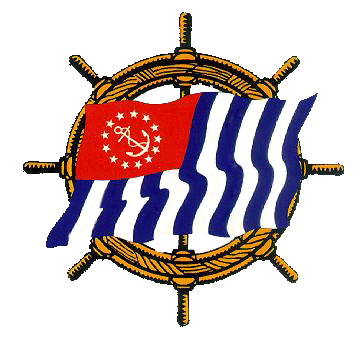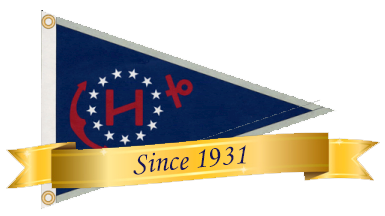Bow Riding
Editor's note: This month's Safety Corner concerns the practice known as Bow Riding and the dangers it entails. The article is written by D/1st Lt Tim Tyler, JN. The opinions are his and do not necessarily reflect the views of the HPS or of the USPS.
If you've been around boating for any length of time, I'm sure you've been introduced to bow riding. For some of us our first exposure is when we're stopped for a violation. My first experience with it was at the ripe old age of sixteen and I had no idea that I was breaking the law. Since that time I've tried to get a good definition of what it entails. My research has not turned up a federal, or "Coast Guard Approved", definition of the term. It appears the Coast Guard enforces state regulations and charges an infraction as "negligent operations". Definitions vary from state to state. For the most part, we of the HPS are Connecticut boaters, so let's take a look at Connecticut law.
From the 2015 Connecticut Boaters Guide...
Riding on Decks or Gunwales
While underway in a vessel under power, do not ride on the bow, gunwale, transom, or in any position which is obviously dangerous. Riding on or hanging over the bow can interfere with stability and may restrict the operator's visibility. No operator of a vessel under power shall allow any person to be on a decked-over bow of such vessel while underway unless the bow of the vessel is equipped with a handrail that encompasses the bow, and all persons on the bow are inward of such handrail. On vessels under power with open bows not decked-over, no operator shall allow any person to sit or stand on the gunwale at the bow of the vessel while underway. These provisions shall not apply to persons in or on the bow of vessels engaged in anchoring, mooring, or docking activities, and when the vessel is proceeding at a dead slow speed.
So if I'm reading it correctly, in Connecticut:
So now we know what's legal in Connecticut, but the real question for me is... is it safe?
In researching this topic on the internet I ran into a lot of discussions on bow riding. Most of the people discussing the topic get hung up on the legality of specific circumstances, the "letter of the law" if you will. I think they're missing the point. The point should be safety, not just legality. The danger lies in the fact that you can be doing everything correctly, within the letter of the law, and still be putting you passengers and crew in danger. Let's take a look at the situations outlined above and see where things might go sideways in a hurry.At reasonable speeds (what's reasonable?) I'm thinking you'd be okay. But let me just say that people tend to think that because some big company produces a boat that it was designed safely and it adheres to some safety guidelines. I have never seen and such guidelines and understand that companies are driven by profit and not safety. I see bow rider boats with no bow rails whatsoever, their occupants hurtling along at 40 mph hanging on for dear life to a tiny bow cleat. Could that submerged object from the example above, or even a large wake from an inconsiderate boater, catapult them out of the boat with similar results? I honestly don't know.
On our boat, with the exception of anchoring, mooring, or docking, the only time anyone is on the bow is when the boat is safely at rest... engines off. When someone goes forward during anchoring, mooring, or docking situations, the engines are placed in neutral until that person has safely made their way to the bow and I have them directly in my line of sight. I understand that props can still be turning in neutral, but there is boat handling to be considered and I feel neutral is a good compromise. Because many things can send a person over the side (wakes, slippery decks, grounding, etc.), my hands are over the kill switches should the necessity to use them arise.
This was not intended to be a comprehensive discussion on bow riding, but instead one meant to provoke thought and discussion about safety. Just because you're legal doesn't mean you're safe. No law can cover all situations. As boat captains we must all make our own decisions we can live with, and so good sense and safety must prevail.
In the words of Mel Brooks... "Hope for the Best. Expect the worst. Life is a play. We're unrehearsed."
Enjoy your boats and stay safe!
If you've been around boating for any length of time, I'm sure you've been introduced to bow riding. For some of us our first exposure is when we're stopped for a violation. My first experience with it was at the ripe old age of sixteen and I had no idea that I was breaking the law. Since that time I've tried to get a good definition of what it entails. My research has not turned up a federal, or "Coast Guard Approved", definition of the term. It appears the Coast Guard enforces state regulations and charges an infraction as "negligent operations". Definitions vary from state to state. For the most part, we of the HPS are Connecticut boaters, so let's take a look at Connecticut law.
From the 2015 Connecticut Boaters Guide...
Riding on Decks or Gunwales
While underway in a vessel under power, do not ride on the bow, gunwale, transom, or in any position which is obviously dangerous. Riding on or hanging over the bow can interfere with stability and may restrict the operator's visibility. No operator of a vessel under power shall allow any person to be on a decked-over bow of such vessel while underway unless the bow of the vessel is equipped with a handrail that encompasses the bow, and all persons on the bow are inward of such handrail. On vessels under power with open bows not decked-over, no operator shall allow any person to sit or stand on the gunwale at the bow of the vessel while underway. These provisions shall not apply to persons in or on the bow of vessels engaged in anchoring, mooring, or docking activities, and when the vessel is proceeding at a dead slow speed.
So if I'm reading it correctly, in Connecticut:
- In a vessel UNDER POWER with a forward deck, but no enclosing rails - NO RIDING ON BOW while underway.
- In a vessel UNDER POWER with a forward deck enclosed with rails - okay to bowride underway as long as body parts don't extend past the gunwales.
- In a vessel UNDER POWER with no forward deck - if you're inward of the gunwales you're okay underway.
- In a vessel UNDER POWER anchoring, mooring, or docking and proceeding at a dead slow speed - okay to be standing in/on the bow and to be outward of the bow rail (if so equipped).
So now we know what's legal in Connecticut, but the real question for me is... is it safe?
In researching this topic on the internet I ran into a lot of discussions on bow riding. Most of the people discussing the topic get hung up on the legality of specific circumstances, the "letter of the law" if you will. I think they're missing the point. The point should be safety, not just legality. The danger lies in the fact that you can be doing everything correctly, within the letter of the law, and still be putting you passengers and crew in danger. Let's take a look at the situations outlined above and see where things might go sideways in a hurry.
- I think with this one we're okay... no one up front, no one to fall overboard.
- Some say this is okay at idle speed (for me that's about 5 mph) but not at cruise. I personally don't think it's ever safe.
Take a situation where someone is sitting up front minding their own business while underway (idle or not).
The boat hits a submerged object and decelerates rapidly. The person sitting on the deck (often slippery and often angled
toward the bow of the boat) keeps moving forward at which point several things could happen:
- They could grab the bow rail and save themselves and there is no harm done to them.
- They could slip off the deck into the water and be run over by the boat which didn't stop completely. In this situation a hull or prop strike is likely to cause severe injury or death.
- They could slide forward and that bow rail meant to protect them could do just the opposite. Slamming your head into that firmly anchored stainless steel rail, even at 5 mph, can do some very serious damage. Imagine the seriousness of the injury if you were going 20 or 40 mph.
On our boat we treat this situation the same as #1 above. No one is on the bow while the vessel is underway.
In the words of Mel Brooks... "Hope for the Best. Expect the worst. Life is a play. We're unrehearsed."
Enjoy your boats and stay safe!

